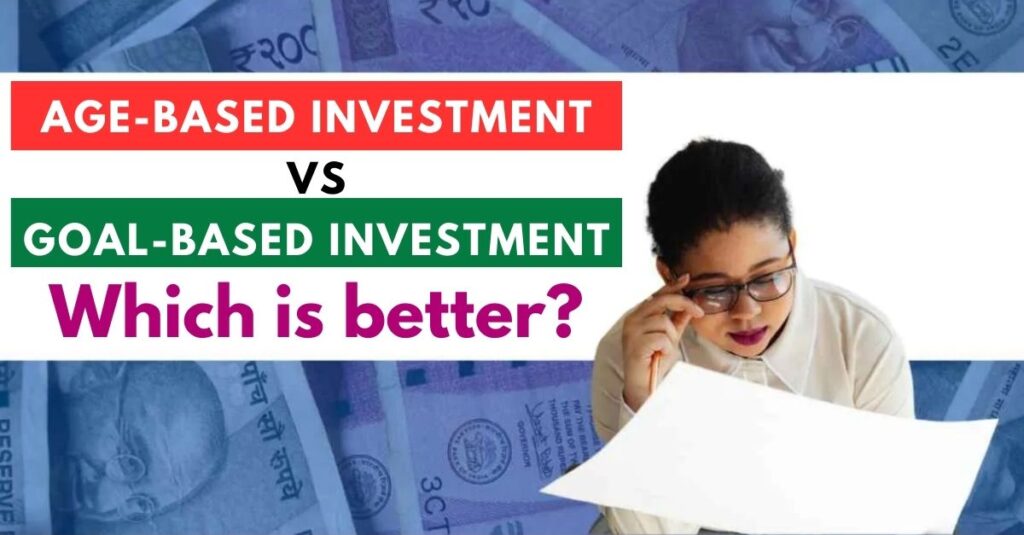Age-based investment vs goal-based investment : Investment for a better future is a good decision for any individual and most people are investing in multiple investment schemes. Investors have to choose the investment plan according to their needs either they can select Age-based investment vs goal-based investment. Both are popular and investors are investing in the schemes according to their needs.
So if you are also planning to invest for a beautiful and better future, then you should know about the difference between age-based investment and goal-based investment. We have discussed some important highlights in this article “Age-based investment vs goal-based investment “, which will help you to identify which works better either age-based investment or goal-based investment.
Age-based investment vs goal based investment
Age-based investment vs goal-based investment : The choice between age-based and goal-based investment strategies depends on various factors, including individual financial goals, risk tolerance, time horizon, and personal preferences. Both approaches have their merits, and what works better for one person may not be the best for another. Let’s explore each strategy.
Age-Based Investment
The age-based investment depends on the investor’s age. As you are younger you will get more opportunities to invest in age-based Investments as younger citizens usually have low life risk. The investment companies use the approach that younger investors can afford to take more risk, so they might have a higher allocation to equities, which have the potential for higher returns but also higher volatility.
The scheme is opted by those individuals who are new in the investment market or do not have proper time to manage their investments as age-based Investments are simple and do not need more attention.
Types of Age-Based Investment Options
There are two main kinds of age-based investment options : retirement accounts and college savings plans.
Retirement Accounts
Retirement accounts are investing vehicles designed to help individuals save for retirement. There are several types of retirement accounts, including traditional individual retirement arrangements (IRAs), Roth IRAs, 401(k)s, and 403(b)s.
Traditional IRA
- A conventional IRA is a tax-deferred retirement account. This means that investors can subtract their contributions from their taxable income, reducing their tax bill.
- However, investors will need to pay taxes on their contributions and earnings when they withdrawal them during retirement.
Roth IRA
- A Roth IRA is a retirement account that lets investors contribute after-tax dollars. The money in a Roth IRA grows tax-free, and investors can withdrawal their contributions and earnings tax-free during retirement.
401(k)
- A 401(k) is a retirement account offering by employers. These accounts allow workers to contribute a portion of their pre-tax income to their retirement savings. Employers frequently match a portion of their employees’ contributions.
403(b)
- A 403(b) is a retirement account offered to employees of public schools, Universities, and certain tax-exempt organizations. Like a 401(k), a 403(b) allows workers to contribute a portion of their pre-tax income to their retirement savings.
College Savings Plans
College savings plans are investment vehicles designed to help families save for their child’s education. There are two main types of college saving plans : 529 plans and Coverdell education savings accounts.
529 plan
- A 529 plan is a tax-benefited savings plan designed to help families save for college. The money in a 529 plan grows tax-free, and withdrawals are tax-free as long as they are used for qualifying education expenses.
Coverdell Education Savings Account
- A Coverdell education savings account is a tax-advantaged savings plan designed to help families save for educational expenses, including K-12 and college.
- Like a 529 plan, the money in a Coverdell account grows tax-free, and withdrawals are tax-free as long as they are used for qualifying education expenses.
Goal Based Investment
The goal-based investments are wider than age-based investments as these investments depend on the individual’s goal and need. Your age factor will not affect your investment and benefits in the goal-based Investments. Anyone should have multiple goals such as Getting their own house, the marriage of their wards, establishing a business after the 50s, Arranging money for the educational purposes of the children, etc.
It is a systematic investment scheme where investors will always be motivated to invest in the scheme to fulfill their specific go
Types of goals based savings
The goals in goal-based saving are based on their saving tenure and their value. The strategies involved in completing them are quite different.
Long-Term Goals :-
- Long-term goal-based saving refers to a savings plan that lasts for at least five or more years. These are the ultimate goals of an investment and savings journey.
- If an investor starts early, they can accumulate a substantial sum for their future with small savings. Investment vehicles to achieve long-term goals are real estate, mutual funds, and equities/shares.
- Examples are retirement plans and savings for a child’s higher education.
Mid-term goals :-
- Mid-term goals are savings plans that last for more than two years and less than five years. Investors find it costly and difficult to save for these goals because the results hover between immediate and long-term.
- Medium-term goals can be achieved by proper planning.
- Investment vehicles to achieve mid-term objectives are debt funds, fixed deposits, and gold investments.
- Examples are : car loans and down payments for buying a house.
Short-Term Goals :-
- Short-term goals are savings plans that last for less than two years. These are repetitive, require disciplined efforts, and are intended for the immediate future.
- Investment vehicles to achieve short-term goals are saving accounts, FDs, and debt mutual funds.
- Examples – Vacation, Jewellery, school fees, a new laptop.
I Bonds vs. Treasury Bills: Which Is the Best Investment in 2023-24?
World Economy Ranking 2023: Top 10 Countries by GDP
Loan Scheme 2024: कर्मचारियों की मौज! बिना ब्याज मिलेगा Loan, मर्जी से चुकाएं EMI
Age-based investment vs goal-based investment : Which works better?
Most investors and financial experts are promoting goal-based investments as it is systematic and motivating for investors to achieve their goals via investing. However, you can consider the following important points before investing in a scheme to set your strategy for the investment:
Risk Tolerance
Age-based strategies may not consider an individual’s risk tolerance as effectively as a goal-based approach. Some people may have a higher risk tolerance regardless of their age, especially if they have a longer-term investment horizon.
Individual Goals
If you have specific financial goals with different time horizons, a goal-based approach may be more suitable. It allows for customization of your portfolio based on the unique requirements of each goal. Every individual has some dreams and these are also their goals, so if you want to invest to get your own home, provide a better education, spend good vacations, Enjoy after retirement, etc.
Active Management
Goal-based strategies may require more active management as priorities and circumstances change. If you prefer a more hands-off approach, an age-based strategy might be simpler to implement. Both approaches can benefit from a well-diversified portfolio. Diversification helps spread risk and optimize returns, regardless of the chosen investment strategy.
The goal-based investment is also safe from multiple investment frauds from new investors as they can invest for their particular goals in the goal-based investment scheme. However, many companies are offering their customers to invest on behalf of their age, so you can invest by checking your specific needs.
Pick investment avenues according to defined goals
When one is aware of the amount required for a goal and the time in hand to accumulate that corpus, one can effectively build their investment strategy. One can then choose to park their money in various avenues as per their investment horizon and financial goals.
For example, if one has defined short-term goals such as travel, kid’s school fees, etc., one would need their money to be accessible to them. With this idea in mind, one can opt for guaranteed insurance plans which provide them with the flexibility to access their returns when necessary. On the other hand, for your medium-term goals (3-5 years away) like purchasing a house, retirement, etc. one can have a mixture of equity & debt in case one has a slightly longer investment horizon.
Invest in protection for unforeseen circumstances
One must always factor the unpredictable circumstances in life, such as inflation, loss of job etc. Factoring all of these while planning your finances provides a safety net during troubles that helps one avoid debt traps.
For example, one may invest in secondary income plans such as a fixed d
Review frequently
Restructuring investments from time to time may be needed as one’s requirements may change as their life progress. Starting one’s investments early is beneficial irrespective of the investment technique as it lends a compounding effect to one’s wealth. However, as the Chinese proverb goes, “The best time to plant a tree was 20 years ago.” The second-best time is now.” Similarly, while it may be ideal to start investing at an early age, it is never too late to start your investment journey no matter the age.
Deposit or guaranteed return insurance plan. Such investments provide the required liquidity that keeps one on their financial track during time of need. Another important factor is having a financial protection net for the family in case of the sudden death of the breadwinning. Therefore, buying protection plans like term life insurance is a must.

